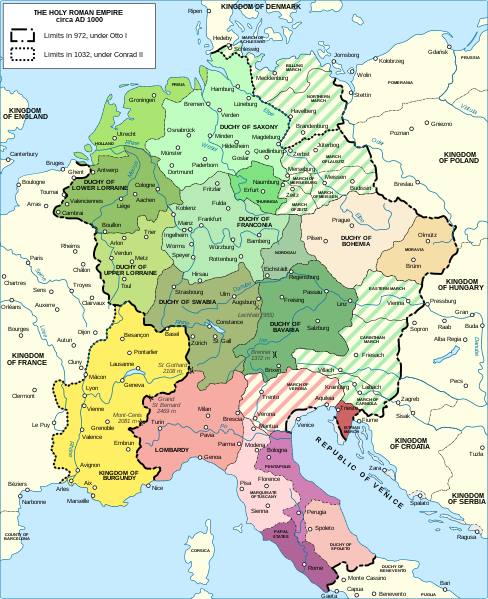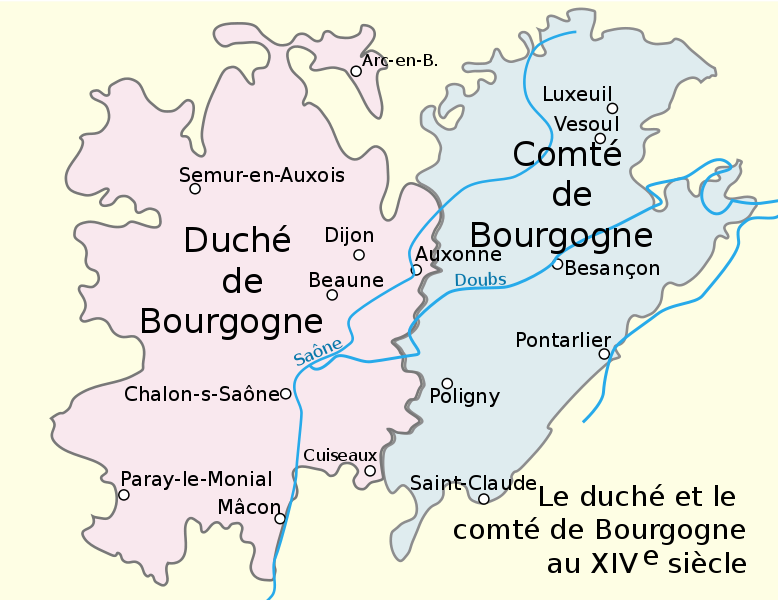Vassalage to the Holy Roman Empire
The county of Burgundy, created around 982, is a fief of the Kingdom of Burgundy formed by the union of the four Carolingian administrative districts (Burgundy pagi): Amous (region of Saône, Ognon and Doubs), Escuens (region of Château-Chalon), Portois (region Port-sur-Saône) and the Varais (region surrounded by the “M” formed by the route of the Doubs river). Originally, its territory corresponded approximately to the current region of Franche-Comté without the Territoire of Belfort and the Pays of Montbéliard. In 1032 the county is embroiled in a crisis: the Burgundy succession. The conflict that took place between 1032 and 1034 saw Eudes II of Blois, closest relative of the deceased king, and the Emperor of the Holy Roman Empire Conrad le Salique (or Conrad II), defender of the testamentary dispositions of the late King Rudolph III in favor of his son, the future Henri III[1]. The resolution of this conflict will see the Kingdom of Burgundy enter the Holy Roman Empire.

Apparition of “Franche-Comté”

As a result of the power struggles, the archbishop of Besançon Hugues I of Salins, who had supported the emperor, obtained in 1043 the royal rights over Besançon. and the title of nobility of prince-bishop, as well as for his successors. This makes the city an ecclesiastical state, detaching itself from the authority of the county of Burgundy, and depending solely on the pope and the emperor. The episcopal principality of Besançon then forms an enclave within the province, acquiring autonomy as an imperial free city under the authority of the Holy Roman Emperor. In 1049, it was Pope Leo IX, friend of Hugues I of Salins, during a visit to Besançon, who confirmed the apostolic, political, and legal authority of the archbishop over the city of Besançon.[2] In 1127, the count of Burgundy Renaud III came into conflict with successive emperors, Lothair II and Conrad III of Hohenstaufen, refusing to recognize their suzerainty. Conrad III confiscates the lands of Renaud III and grants them to Conrad of Zähringen. Renaud III then went to war against Conrad III, but beaten by Conrad of Zähringen, he had to cede his possessions to him east of the Jura. Following this event, he was nicknamed the franc-comte (translated as “free count”) which would be the origin of the name of the Franche-Comté region.
European conflicts and annexation to France
In 1290, a conflict between laity and clerics sees Besançon free itself from the power of the archbishops, while remaining subject to the emperor, but not to the count of Burgundy. It forms the free city of the Empire of Besançon and governs itself, thanks to a council of twenty-eight notables elected by universal male suffrage at several levels and a council of fourteen governors appointed by the notables. Othon IV, duke of Burgundy, in response, sought support from France. On March 2, 1295, by the convention of Vincennes, he decided to sell the county to the king of France, Philippe le Bel. The county of Burgundy came under French influence for the first time, although it was still under Germanic suzerainty. In the following centuries, the Kingdom of Burgundy saw numerous wars of successions and independances against its neighbours, France and the Holy Roman Empire, and was finally conquered by France during the Dutch War in 1674, becoming the French region of Franche-Comté.
- [1]WOLGRAM Herwig, Conrad II, 990-1039: Emperor of Three Kingdoms, University Park, PA, Penn State Press, 2010, 475 p.
- [2]RICHARD Jean François Nicolas, Histoire des diocèses de Besançon et de Saint-Claude, t. 1, Besançon, Librairie ecclésiastique de Cornu, 1847, 637 p.